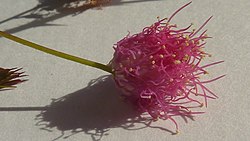Biology:Mimosa somnians
| Mimosa somnians | |
|---|---|

| |
| Scientific classification | |
| Kingdom: | Plantae |
| Clade: | Tracheophytes |
| Clade: | Angiosperms |
| Clade: | Eudicots |
| Clade: | Rosids |
| Order: | Fabales |
| Family: | Fabaceae |
| Subfamily: | Caesalpinioideae |
| Clade: | Mimosoid clade |
| Genus: | Mimosa |
| Species: | M. somnians
|
| Binomial name | |
| Mimosa somnians Humb. & Bonpl. ex Willd.[1]
| |
| Synonyms[2] | |
| |
Mimosa somnians, commonly known as dormideira, is a species of woody shrub in the genus Mimosa and the family Fabaceae. It is native to the Caribbean, Central America and South America.[2] It is a short, low-lying shrub with minuscule thorns lining its stem-like hairs.[3]
Mimosa somnians is notable for exhibiting rapid plant movement. Its leaves are sensitive to tactile stimulus, folding quickly when touched, similar to Mimosa pudica.[4] It can be differentiated from Mimosa pudica in that its leaves are bipinnate, there are more than four subbranchlets and these originate from more than one point on the branch.[4]
Mimosa somnians's leaflets are 4–5 mm long.[3] The flowers form pink balls.[3] It propagates by seeds.[4]
Forms, subspecies and varieties
- Mimosa somnians f. viscida
- Mimosa somnians subsp. longipes
- Mimosa somnians subsp. viscida
- Mimosa somnians var. aquatica
- Mimosa somnians var. deminuta
- Mimosa somnians var. diminuta
- Mimosa somnians var. glandulosa
- Mimosa somnians var. lasiocarpa
- Mimosa somnians var. leptocaulis
- Mimosa somnians var. longipes
- Mimosa somnians var. lupulina
- Mimosa somnians var. possensis
- Mimosa somnians var. somnians
- Mimosa somnians var. velascoensis
- Mimosa somnians var. viscida
Uses
In Guyana, it is used to calm down irritable children via washing.[5]
Chemical constituents
Mimosa somnians contains (whole plant) about 0.029% tryptamine and about 0.029% methyltryptamine.[6]
References
- ↑ {{citation | mode = cs1 | title = Mimosa somnians | work = Germplasm Resources Information Network (GRIN) | url = | publisher = [[Organization:Agricultural Research ServAgricultural Research Service (ARS), United States Department of Agriculture (USDA) | access-date = 2008-05-07 }}
- ↑ 2.0 2.1 "Mimosa somnians - ILDIS LegumeWeb". www.ildis.org. http://www.ildis.org/LegumeWeb?sciname=Mimosa+somnians. Retrieved 2008-05-07.
- ↑ 3.0 3.1 3.2 "Full text of "Flora of Yucatan"". https://archive.org/stream/floraofyucatanfistan/floraofyucatanfistan_djvu.txt. Retrieved 2008-05-08.
- ↑ 4.0 4.1 4.2 "Translated version of http://laflor.ifas.ufl.edu/Weeds%20of%20CR/cd/MALEZAS/leguminosas/Mimosa%20somnians.html". https://translate.google.com/translate?hl=en&sl=es&u=http://laflor.ifas.ufl.edu/Weeds%2520of%2520CR/cd/MALEZAS/leguminosas/Mimosa%2520somnians.html&sa=X&oi=translate&resnum=9&ct=result&prev=/search%3Fq%3D%2522Mimosa%2Bsomnians%2522%26start%3D110%26hl%3Den%26safe%3Doff%26client%3Dfirefox-a%26rls%3Dcom.mandriva:en-US:official%26sa%3DN%26ie%3DUTF-8%26oe%3DUTF-8. Retrieved 2008-05-08.
- ↑ Medicinal Plants of the Guianas (Guyana, Surinam, French Guiana), Retrieved 5-07-08
- ↑ Gupta, M. P.; Arias, T. D.; Etheart, J.; Hatfield, G. M. (1979). "The Occurrence of Tryptamine and N-Methyltryptamine in Mimosa somnians". Journal of Natural Products 42 (2): 234–236. doi:10.1021/np50002a017. PMID 27802381.
Wikidata ☰ Q13933651 entry
 |

